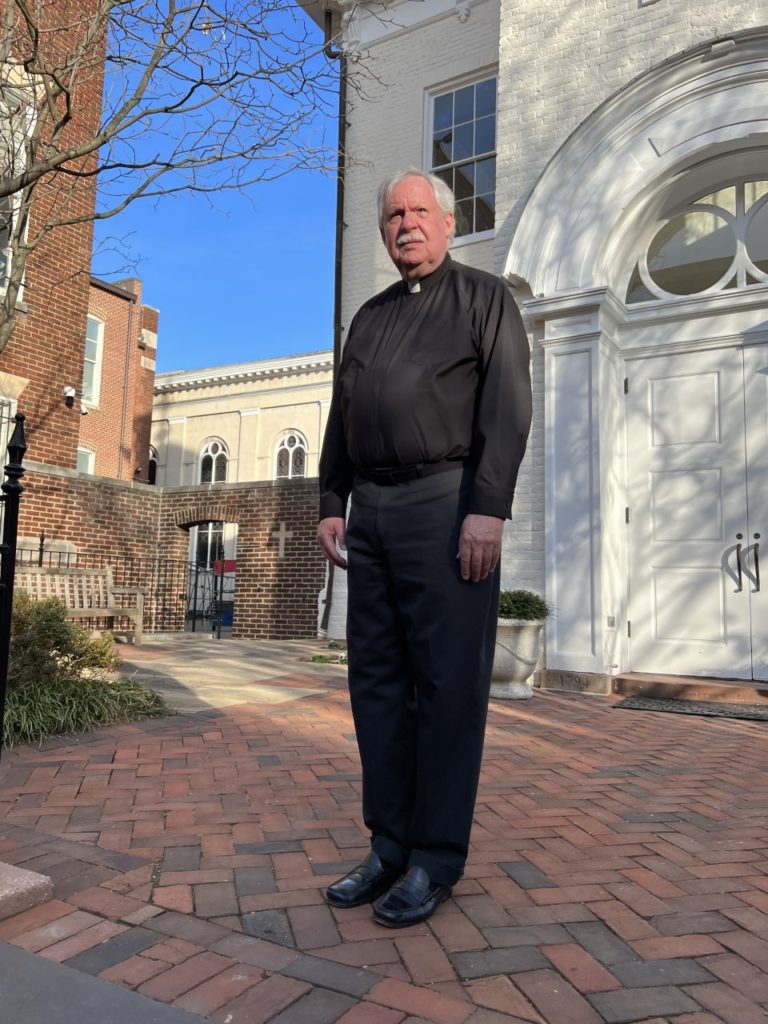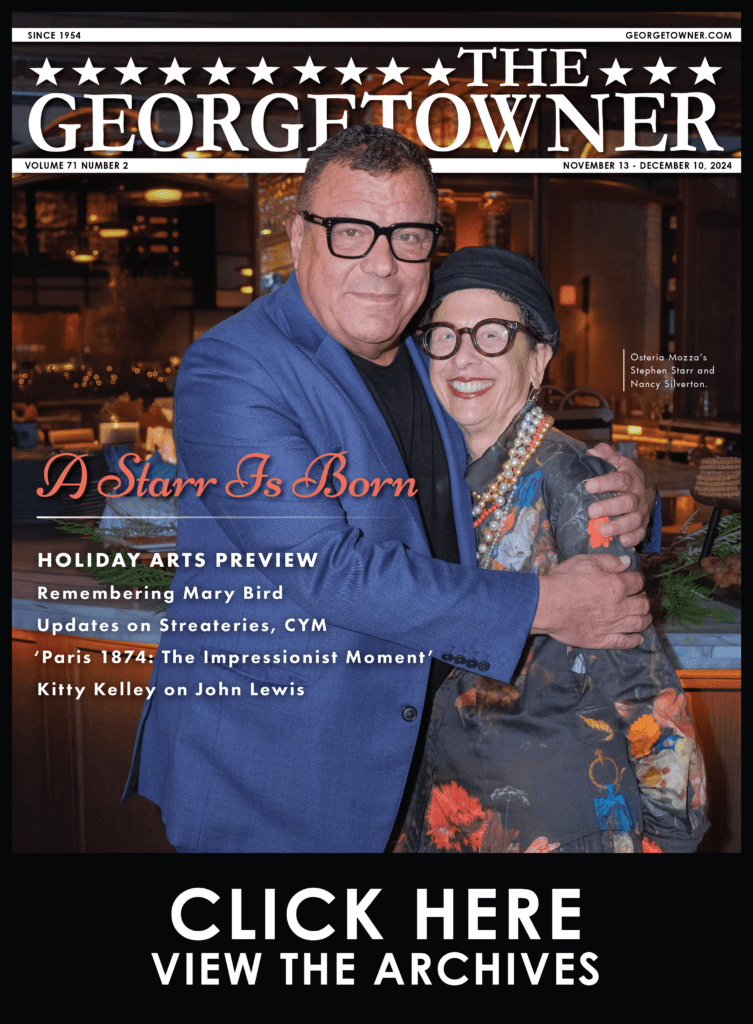Mapping Georgetown: Holy Trinity Associate Pastor Reflects on Racial Inequities and the ‘Anawim’
By • February 21, 2023 0 1626

Rev. Ben Hawley, S.J., associate pastor at Holy Trinity Parish sent his reflections on Georgetown cemeteries. The reflections are a story within a story from a Jesuit with a fascinating life story of his own. Thank you, Father, for sharing some food for thought — especially during Black History Month.
“Seek the Lord, all you humble of the earth, who have observed his law; seek justice, seek humility; perhaps you may be sheltered on the day of the Lord’s anger (Zephaniah 2:3).
The prophet Zephaniah is speaking to the poorest people of his own time, the faithful remnant, the “Anawim,” in Hebrew, those who suffer the worst of injustices and are the least known.
Who might the Anawim be in our day?
One sunny afternoon, I walked down R Street and passed Dumbarton Oaks, an 1800s estate now owned by Harvard University. I then passed Oak Hill Cemetery, founded in 1848 on 22 acres of land, with its Renwick Chapel, its clipped hedges and neat lawns. It was established by William Corcoran, founder of Riggs Bank (now PNC Bank) and founder of the Corcoran Gallery of Art. The cemetery houses 20,000 or so people and is listed on the National Register of Historical Places.
I followed the road to the right onto 28th Street and walked alongside the former Evermay Estate, a four-acre property with a house dating from 1800. It was paid for by the profits its owner received from selling the land to the federal government. The Evermay Estate property is now valued at $26 million.
I turned east on Q Street and passed Dumbarton House, also built around 1800, also listed on the National Register of Historic Places. Its lower floors opened as a museum in 1928 to “illustrate domestic life in Georgetown in the early federal period.”
As to who worked on the estate, you would need to consult the website of the Georgetown African American Historic Landmark Project and Tour with photos and entries for nearly 100 sites in Georgetown, including Holy Trinity, Holy Rood Cemetery, and the Jesuit cemetery on the university campus. The Landmark Project website says that both enslaved and free Blacks worked at Dumbarton House in the first half of the 19th century. The man who owned the property owned slaves even prior to owning this house.
I turned left and walked into what seemed at first a very pleasant park of tall trees and grass. A plaque welcomed me to the Mount Zion Cemetery, which encompassed the Old Methodist Burial Ground to the right and the Female Union Band Society Cemetery to the left, in a single space. The Female Band Society, formed in 1842 by formerly enslaved black women led by Mary Turner, was a cooperative benevolent association of free Black women pledged to assist one another in sickness and in death. The Society acquired this property to fulfill its commitment to provide graves for its members, according to the website.
The Mount Zion Cemetery originated in a purchase of land in 1808 by the Montgomery Street Methodist Church. After multiple changes of hands, Mount Zion Church gained ownership of the cemetery and today is owned by the Dumbarton United Methodist Church.
Recent research has revealed 6,300 recorded burials here in the 1880-1930 period, according to DC Health Office records, though some believe that many more were buried here with no written record.
I could see a few gravestones in the distance to the left and a larger number of them to the right, some upright, some laid side by side. I saw no neat rows of stones or well cared for lanes for walking or well-tended plants or trees.
Not surprisingly, that was exactly what I saw through the leafless trees across the steep, narrow valley to my left in the lower reaches of Oak Hill Cemetery. Without knowing much of the story beyond what the plaque told me, I already saw—in what for me was a new way—the reality of racial segregation manifested in death as in life. I saw the rich and the poor, the haves and have nots, the masters and the slaves, the known and named, the unknown and unnamed.
As if this were not bad enough, I then heard this story: On Sept. 25, 2021, construction workers widening the bicycle path alongside Rock Creek began digging into cemetery land. No prior notice was given to the Mount Zion-Female Union Band Society Historic Memorial Park Foundation. The D.C. Department of Transportation and the U.S. Park Service should have contacted Memorial Park staff in a routine consultation under their own regulations.
When Julia Washburn, Rock Creek Park Superintendent and Mount Zion-Female Union Band Society Historic Memorial Park Foundation Executive Director Lisa Fager met to review the matter, they looked at a current map of federal park land in the city. Guess what they found? Oak Hill Cemetery was on the map and the two black cemeteries were not. Fortunately, the agencies agreed to cease work on the bike path until proper studies could be done, and the Park Service has since corrected and reissued the map.
A new book entitled “Over My Dead Body: Unearthing the Hidden Histories of America’s Cemeteries” by Greg Melville reports that the same segregation by race and quality of investment is to be found at Laurel Grove Cemetery in Savannah, Georgia, and Brewer Hill Cemetery in Annapolis, among others.
I have met the Anawim of an earlier era, right where I live. Now that you have heard my story, what is your story and your reaction to these realities? These realities connect quickly in my mind with the extraordinary racial violence of today, and so many other forms of violence in our world. I am speechless. I lack words. Maybe you do too. So, instead, let’s let the prophet Zephaniah speak for us:
Ah, soiled, defiled, oppressing city! It has listened to no voice. It has accepted no correction. It has not trusted in the Lord, it has not drawn near to its God. The officials within it are roaring lions. Its judges are evening wolves that leave nothing in the morning. Its prophets are reckless, faithless persons. Its priests have profaned what is sacred. They have done violence to the law. (3:1-5).
Zephaniah prophesied, and Jesus our Savior appeared as one like us, to save us all from Satan’s power when we had gone astray, to bring glad tidings of comfort and joy. He was one of the Anawim of his day, he came from on the wrong side of the urban and rural divide, the coastal elite class and working-class divide, the educational divide and the Roman and Jewish divide. He spoke up. He was killed and buried without identification in someone else’s grave.
He rose again to new life and is our hope. His death and resurrection are our salvation. His blood cleanses us and his body feeds us. His words and his spirit live on in us, not just us, but most especially the Anawim among us, the first fruits of his redemption.
We are here today to allow him to feed us, for his love to restore us, and for his word to fill us as his word filled Zephaniah, so that he can send us out with words of comfort for the Anawim and words of hope for everyone, into a world where we can easily be overwhelmed by violence, endless stories of shootings and corruption. He will save us, and the Anawim are waiting for us. They rely on our work.
Oral Catholic tradition says that we will be reunited with our loved ones when we have made our Passover and are with the Lord. I told my therapist some years ago that the idea of meeting my family made me nervous. He smiled and said, “Maybe you need some more therapy!”
Maybe so. What is even more true is that you and I may meet those whose mortal remains are buried here. We can hear their stories and see their faces as they stand before us. Let’s be ready to hear their stories. What stories they will be!
Rev Benjamin B. Hawley, S.J., is Associate Pastor at Holy Trinity Parish in Georgetown. He previously served as Pastor of St. Mary Student Parish in Ann Arbor, Michigan, ministering to those at the University of Michigan, including members of the football team and coaches. Rev. Hawley holds degrees from Heythrop College of London, the University of Chicago, Loyola University Chicago and Cornell University. He became Catholic and Jesuit in mid-life and also served as a Peace Corps Volunteer in Burkina Faso (then Upper Volta) and as a Foreign Service Officer in Jakarta, Indonesia; Washington, D.C., as desk officer for Lebanon, Jordan, West Bank and Gaza; and in Sana’a, Yemen.

